
Willow Tearooms
Encyclopedia
The Willow Tearooms are tearooms at 217 Sauchiehall Street
, Glasgow
, Scotland
, designed by internationally renowned architect
Charles Rennie Mackintosh
, which opened for business in October 1903. They quickly gained enormous popularity, and are the most famous of the many Glasgow tearooms that opened in the late 19th and early 20th century.
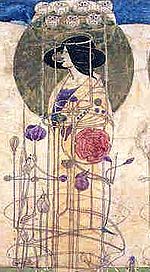 Early in his career, in 1896, Mackintosh met Catherine Cranston
Early in his career, in 1896, Mackintosh met Catherine Cranston
(widely known as Kate Cranston or simply Miss Cranston), an entrepreneurial local business woman who was the daughter of a Glasgow tea
merchant and a strong believer in temperance
.
The temperance movement was becoming increasingly popular in Glasgow at the turn of the century and Miss Cranston had conceived the idea of a series of "art tearooms", venues where people could meet to relax and enjoy non-alcoholic refreshments in a variety of different "rooms" within the same building. This proved to be the start of a long working relationship between Miss Cranston and Mackintosh. Between 1896 and 1917 he designed and re-styled interiors in all four of her Glasgow tearooms, often in collaboration with his wife Margaret MacDonald
.
s of her new Buchanan Street
tearooms in 1896. The tearooms had been designed and built by George Washington Browne
of Edinburgh
, with interiors and furnishings being designed by George Walton. Mackintosh designed stencil
led frieze
s depicting opposing pairs of elongated female figures surrounded by roses for the ladies’ tearoom, the luncheon room and the smokers’ gallery.
In 1898, his next commission for the existing Argyle Street
tearooms saw the design roles reversed, with Mackintosh designing the furniture and interiors, and Walton designing the wall murals. This was to see the first appearance of Mackintosh's trademark high-backed chair design. In 1900 Miss Cranston commissioned him to redesign an entire room in her Ingram Street tearooms, which resulted in the creation of the White Dining Room. Patrons entering the dining room from Ingram Street had to pass through a hallway separated from the room by a wooden screen with leaded glass
inserts, offering tantalising glimpses of the experience to come.
This led to the commission to design completely the proposed new tearooms in Sauchiehall Street in 1903. For the first time, Mackintosh was given responsibility for not only the interior design and furniture, but also for the full detail of the internal layout and exterior architectural treatment. The resultant building came to be known as the Willow Tearooms, and is the best known and most important work that Mackintosh undertook for Miss Cranston.
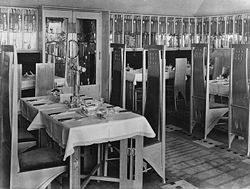 The location selected by Miss Cranston for the new tearooms was a four-storey former warehouse building on a narrow infill
The location selected by Miss Cranston for the new tearooms was a four-storey former warehouse building on a narrow infill
urban
site on the south side of Sauchiehall Street. The name "Sauchiehall" is derived from "saugh", the Scots
word for a willow
tree, and "haugh", meadow
. This provided the starting point for Mackintosh and MacDonald's ideas for the design theme.
Within the existing structure, Mackintosh designed a range of spaces with different functions and decor for the Glasgow patrons to enjoy. There was a ladies’ tearoom to the front of the ground floor, with a general lunch room to the back and a tea gallery above it. The first floor contained the "Room de Luxe", a more exclusive ladies' room overlooking Sauchiehall Street. The second floor contained a timber-panelled billiards
room and smoking rooms for the men. The design concept foresaw a place for the ladies to meet their friends, and for the men to use on their breaks from office work - an oasis in the city centre.
The decoration of the different rooms was themed: light for feminine, dark for masculine. The ladies' tea room at the front was white, silver, and rose; the general lunch room at the back was panelled in oak and grey canvas, and the top-lit tea gallery above was pink, white, and grey. In addition to designing the internal architectural alterations and a new external facade, in collaboration with his wife Margaret, Mackintosh designed almost every other aspect of the tearooms, including the interior design
, furniture
, cutlery, menus, and even the waitress uniforms. Willow was the basis for the name of the tearooms, but it also formed an integral part of the decorative motif
s employed in the interior design, and much of the timberwork used in the building fabric and furniture.
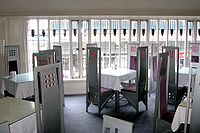 The Room de Luxe was the most extravagant of the rooms that Mackintosh created, and proved to be the tearooms' main attraction. The room was positioned on the first floor at the front of the building, slightly above the level of the tea gallery at the rear, and featured a vaulted
The Room de Luxe was the most extravagant of the rooms that Mackintosh created, and proved to be the tearooms' main attraction. The room was positioned on the first floor at the front of the building, slightly above the level of the tea gallery at the rear, and featured a vaulted
ceiling with a full-width, slightly curved bay window
looking out to Sauchiehall Street. Entrance to the room was by way of a magnificent set of double doors which featured leaded glass decoration, hinting at the colours and motifs to be found beyond.
 Described at the time as "a fantasy for afternoon tea", the room was intimate and richly decorated. It featured a sumptuous colour scheme of grey, purple and white, featuring a soft grey carpet, a silk
Described at the time as "a fantasy for afternoon tea", the room was intimate and richly decorated. It featured a sumptuous colour scheme of grey, purple and white, featuring a soft grey carpet, a silk
upholstered dado
, chairs and settees upholstered
in a rich rose-purple, and silver painted tables with high-backed chairs. The walls were painted a simple white, with a high level frieze of coloured, mirrored and leaded glass panels. One side wall contained the fireplace and, opposite, the other wall featured one of Margaret MacDonald's most famous works, the gesso
panel inspired by Rossetti
's sonnet
O Ye, all ye that walk in Willow Wood. This was all complemented by crisp, white tablecloths and blue willow-pattern crockery.
The luxurious decoration of the room can be understood as a logical extension of the Mackintosh's stylistic development from 1900, where they would develop all-encompassing interior designs for domestic commissions, and then transfer these to their designs for commercial projects and exhibitions. Their colourful interior designs in the House for an Art Lover
culminated in the Room de Luxe interior as a commercial vision of the Europe
an idea of the room as a work of art.
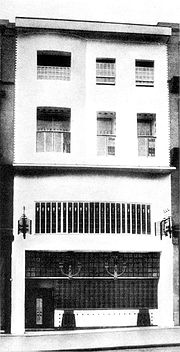 Mackintosh's redesigned external facade was a carefully considered asymmetric
Mackintosh's redesigned external facade was a carefully considered asymmetric
, abstractly modelled composition with shallow curves on some areas of the surface, and varying depths of recesses to windows and the main entrance. The composition respected the urban context of the neighbouring buildings, matching the major cornice
lines and heights of adjoining buildings, whilst still exploring emerging ideas of Art Nouveau
and the modern movement
.
The ground floor entrance door is placed far to the left of a wide band of fenestration
, both of which are recessed below the first-floor level, the location of the Room de Luxe. To emphasise the importance of this room, Mackintosh designed a full width bay window
, projecting the facade outwards with a gentle curve. The two storeys above this featured a more regular pattern of fenestration with three individual windows per floor, recessed to different degrees. The asymmetry of the composition was continued by widening the left side windows and creating another gentle curve in this part of the facade, extending through both storeys. This repeated the curved form of the first floor and emphasised the heavily recessed entrance to the building below.
Mackintosh chose to finish the facade in a white-painted smooth render
, in contrast to the natural stone finish of nearby buildings. This decision, plus the use of small paned windows and ornamental tile inserts forming a chequered border around the perimeter of the facade, gave it an elegance and lightness of touch appropriate for its purpose. The domestic-style leaded glass announced the intimacy of the interior and hinted at the luxurious willow theme to be found inside.
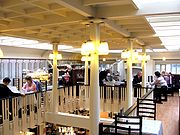 Following the death of her husband in 1917, Miss Cranston sold her businesses. The Willow Tearooms continued in use under a new name until they were incorporated into Daly's department store in 1928. By 1938 the others had passed into the hands of Cranston's Tearooms Ltd. When this company went into liquidation in 1954 the tearooms were sold and subsequently put to a number of different uses over the years. Though Daly's adapted the Willow Tearooms building as part of their department store, the façade was unchanged above their ground floor plate glass shop window and fascia, the moulded plaster frieze could still be seen above the ground floor shopfittings, and the Room de Luxe remained in use as the department store tea room until they closed around the start of the 1980s.
Following the death of her husband in 1917, Miss Cranston sold her businesses. The Willow Tearooms continued in use under a new name until they were incorporated into Daly's department store in 1928. By 1938 the others had passed into the hands of Cranston's Tearooms Ltd. When this company went into liquidation in 1954 the tearooms were sold and subsequently put to a number of different uses over the years. Though Daly's adapted the Willow Tearooms building as part of their department store, the façade was unchanged above their ground floor plate glass shop window and fascia, the moulded plaster frieze could still be seen above the ground floor shopfittings, and the Room de Luxe remained in use as the department store tea room until they closed around the start of the 1980s.
Extensive restoration work was carried out under the architect Geoffrey Wimpenny of Keppie Henderson, successors of the Honeyman, Keppie and Mackintosh partnership of almost a century earlier. The Willow Tearooms reopened in 1983 with the restored ground floor façade forming the shop front to Henderson the jewellers which occupied the ground floor and the reconstructed gallery.
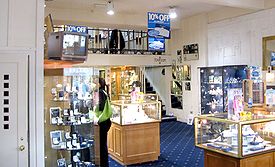 At the same time the Room de Luxe was refurbished to recreate the original colour scheme, and furnished with reproductions of the high back chairs, though originally there were only eight of these chairs at formal central tables while chairs around the perimeter had lower backs. It was reopened in 1983 by Anne Mulhern, a Glasgow business woman, and in 1996 she also leased the tea gallery at the rear of the building. Today, visitors can once again experience some of the Willow Tearooms as Mackintsoh intended. In 1997 "The Willow" expanded into new Tearooms at 97 Buchanan Street, next door to the original Miss Cranston tearooms. These feature recreations of the original designs that Mackintosh created as the "White Dining Room" and "Chinese Room" for Miss Cranston's nearby Ingram Street tearoom. The tea room however has fallen into disrepair and is now lacking its originally intended atmosphere and quality. Fans of Mackintosh are urgently calling for a more sympathetic restoration.
At the same time the Room de Luxe was refurbished to recreate the original colour scheme, and furnished with reproductions of the high back chairs, though originally there were only eight of these chairs at formal central tables while chairs around the perimeter had lower backs. It was reopened in 1983 by Anne Mulhern, a Glasgow business woman, and in 1996 she also leased the tea gallery at the rear of the building. Today, visitors can once again experience some of the Willow Tearooms as Mackintsoh intended. In 1997 "The Willow" expanded into new Tearooms at 97 Buchanan Street, next door to the original Miss Cranston tearooms. These feature recreations of the original designs that Mackintosh created as the "White Dining Room" and "Chinese Room" for Miss Cranston's nearby Ingram Street tearoom. The tea room however has fallen into disrepair and is now lacking its originally intended atmosphere and quality. Fans of Mackintosh are urgently calling for a more sympathetic restoration.
Sauchiehall Street
Sauchiehall Street is one of the main shopping/business streets in the city centre of Glasgow, Scotland. Along with Buchanan Street and Argyle Street, it forms the main shopping area of Glasgow, containing the majority of Glasgow's high street and chain stores.Although commonly associated with the...
, Glasgow
Glasgow
Glasgow is the largest city in Scotland and third most populous in the United Kingdom. The city is situated on the River Clyde in the country's west central lowlands...
, Scotland
Scotland
Scotland is a country that is part of the United Kingdom. Occupying the northern third of the island of Great Britain, it shares a border with England to the south and is bounded by the North Sea to the east, the Atlantic Ocean to the north and west, and the North Channel and Irish Sea to the...
, designed by internationally renowned architect
Architect
An architect is a person trained in the planning, design and oversight of the construction of buildings. To practice architecture means to offer or render services in connection with the design and construction of a building, or group of buildings and the space within the site surrounding the...
Charles Rennie Mackintosh
Charles Rennie Mackintosh
Charles Rennie Mackintosh was a Scottish architect, designer, watercolourist and artist. He was a designer in the Arts and Crafts movement and also the main representative of Art Nouveau in the United Kingdom. He had a considerable influence on European design...
, which opened for business in October 1903. They quickly gained enormous popularity, and are the most famous of the many Glasgow tearooms that opened in the late 19th and early 20th century.
Background

Catherine Cranston
Catherine Cranston , widely known as Kate Cranston or Miss Cranston, was a leading figure in the development of the social phenomenon of tea rooms. She is nowadays chiefly remembered as a major patron of Charles Rennie Mackintosh and Margaret MacDonald, in Glasgow, Scotland...
(widely known as Kate Cranston or simply Miss Cranston), an entrepreneurial local business woman who was the daughter of a Glasgow tea
Tea
Tea is an aromatic beverage prepared by adding cured leaves of the Camellia sinensis plant to hot water. The term also refers to the plant itself. After water, tea is the most widely consumed beverage in the world...
merchant and a strong believer in temperance
Temperance movement
A temperance movement is a social movement urging reduced use of alcoholic beverages. Temperance movements may criticize excessive alcohol use, promote complete abstinence , or pressure the government to enact anti-alcohol legislation or complete prohibition of alcohol.-Temperance movement by...
.
The temperance movement was becoming increasingly popular in Glasgow at the turn of the century and Miss Cranston had conceived the idea of a series of "art tearooms", venues where people could meet to relax and enjoy non-alcoholic refreshments in a variety of different "rooms" within the same building. This proved to be the start of a long working relationship between Miss Cranston and Mackintosh. Between 1896 and 1917 he designed and re-styled interiors in all four of her Glasgow tearooms, often in collaboration with his wife Margaret MacDonald
Margaret MacDonald (artist)
Margaret MacDonald Mackintosh was a Scottish artist whose design work became one of the defining features of the "Glasgow Style" during the 1890s....
.
The early tearooms
Mackintosh was engaged to design the wall muralMural
A mural is any piece of artwork painted or applied directly on a wall, ceiling or other large permanent surface. A particularly distinguishing characteristic of mural painting is that the architectural elements of the given space are harmoniously incorporated into the picture.-History:Murals of...
s of her new Buchanan Street
Buchanan Street
Buchanan Street is one of the main shopping thoroughfares in Glasgow, the largest city in Scotland. It forms the central stretch of Glasgow's famous shopping district with a generally more upmarket range of shops than the neighbouring streets: Argyle Street, and Sauchiehall Street.-History:...
tearooms in 1896. The tearooms had been designed and built by George Washington Browne
George Washington Browne
Sir George Washington Browne FRIBA was a Scottish architect. He was born in Glasgow, and trained there and in London...
of Edinburgh
Edinburgh
Edinburgh is the capital city of Scotland, the second largest city in Scotland, and the eighth most populous in the United Kingdom. The City of Edinburgh Council governs one of Scotland's 32 local government council areas. The council area includes urban Edinburgh and a rural area...
, with interiors and furnishings being designed by George Walton. Mackintosh designed stencil
Stencil
A stencil is a thin sheet of material, such as paper, plastic, or metal, with letters or a design cut from it, used to produce the letters or design on an underlying surface by applying pigment through the cut-out holes in the material. The key advantage of a stencil is that it can be reused to...
led frieze
Frieze
thumb|267px|Frieze of the [[Tower of the Winds]], AthensIn architecture the frieze is the wide central section part of an entablature and may be plain in the Ionic or Doric order, or decorated with bas-reliefs. Even when neither columns nor pilasters are expressed, on an astylar wall it lies upon...
s depicting opposing pairs of elongated female figures surrounded by roses for the ladies’ tearoom, the luncheon room and the smokers’ gallery.
In 1898, his next commission for the existing Argyle Street
Argyle Street
Argyle Street is the name of a street in many cities and towns. Notable among these are:Australia*Argyle Street, the Rocks, Sydney*Argyle Street, Hobart, Tasmania*Argyle Street, Fitzroy, MelbourneCanada*Argyll Road, Edmonton...
tearooms saw the design roles reversed, with Mackintosh designing the furniture and interiors, and Walton designing the wall murals. This was to see the first appearance of Mackintosh's trademark high-backed chair design. In 1900 Miss Cranston commissioned him to redesign an entire room in her Ingram Street tearooms, which resulted in the creation of the White Dining Room. Patrons entering the dining room from Ingram Street had to pass through a hallway separated from the room by a wooden screen with leaded glass
Stained glass
The term stained glass can refer to coloured glass as a material or to works produced from it. Throughout its thousand-year history, the term has been applied almost exclusively to the windows of churches and other significant buildings...
inserts, offering tantalising glimpses of the experience to come.
This led to the commission to design completely the proposed new tearooms in Sauchiehall Street in 1903. For the first time, Mackintosh was given responsibility for not only the interior design and furniture, but also for the full detail of the internal layout and exterior architectural treatment. The resultant building came to be known as the Willow Tearooms, and is the best known and most important work that Mackintosh undertook for Miss Cranston.
The Willow Tearooms

Infill
Infill in its broadest meaning is material that fills in an otherwise unoccupied space. The term is commonly used in association with construction techniques such as wattle and daub, and civil engineering activities such as land reclamation.-Construction:...
urban
Urban area
An urban area is characterized by higher population density and vast human features in comparison to areas surrounding it. Urban areas may be cities, towns or conurbations, but the term is not commonly extended to rural settlements such as villages and hamlets.Urban areas are created and further...
site on the south side of Sauchiehall Street. The name "Sauchiehall" is derived from "saugh", the Scots
Scots language
Scots is the Germanic language variety spoken in Lowland Scotland and parts of Ulster . It is sometimes called Lowland Scots to distinguish it from Scottish Gaelic, the Celtic language variety spoken in most of the western Highlands and in the Hebrides.Since there are no universally accepted...
word for a willow
Willow
Willows, sallows, and osiers form the genus Salix, around 400 species of deciduous trees and shrubs, found primarily on moist soils in cold and temperate regions of the Northern Hemisphere...
tree, and "haugh", meadow
Meadow
A meadow is a field vegetated primarily by grass and other non-woody plants . The term is from Old English mædwe. In agriculture a meadow is grassland which is not grazed by domestic livestock but rather allowed to grow unchecked in order to make hay...
. This provided the starting point for Mackintosh and MacDonald's ideas for the design theme.
Within the existing structure, Mackintosh designed a range of spaces with different functions and decor for the Glasgow patrons to enjoy. There was a ladies’ tearoom to the front of the ground floor, with a general lunch room to the back and a tea gallery above it. The first floor contained the "Room de Luxe", a more exclusive ladies' room overlooking Sauchiehall Street. The second floor contained a timber-panelled billiards
Billiards
Cue sports , also known as billiard sports, are a wide variety of games of skill generally played with a cue stick which is used to strike billiard balls, moving them around a cloth-covered billiards table bounded by rubber .Historically, the umbrella term was billiards...
room and smoking rooms for the men. The design concept foresaw a place for the ladies to meet their friends, and for the men to use on their breaks from office work - an oasis in the city centre.
The decoration of the different rooms was themed: light for feminine, dark for masculine. The ladies' tea room at the front was white, silver, and rose; the general lunch room at the back was panelled in oak and grey canvas, and the top-lit tea gallery above was pink, white, and grey. In addition to designing the internal architectural alterations and a new external facade, in collaboration with his wife Margaret, Mackintosh designed almost every other aspect of the tearooms, including the interior design
Interior design
Interior design describes a group of various yet related projects that involve turning an interior space into an effective setting for the range of human activities are to take place there. An interior designer is someone who conducts such projects...
, furniture
Furniture
Furniture is the mass noun for the movable objects intended to support various human activities such as seating and sleeping in beds, to hold objects at a convenient height for work using horizontal surfaces above the ground, or to store things...
, cutlery, menus, and even the waitress uniforms. Willow was the basis for the name of the tearooms, but it also formed an integral part of the decorative motif
Motif (art)
In art, a motif is an element of a pattern, an image or part of one, or a theme. A motif may be repeated in a design or composition, often many times, or may just occur once in a work. A motif may be an element in the iconography of a particular subject or type of subject that is seen in other...
s employed in the interior design, and much of the timberwork used in the building fabric and furniture.
The Room Deluxe

Vault (architecture)
A Vault is an architectural term for an arched form used to provide a space with a ceiling or roof. The parts of a vault exert lateral thrust that require a counter resistance. When vaults are built underground, the ground gives all the resistance required...
ceiling with a full-width, slightly curved bay window
Bay window
A bay window is a window space projecting outward from the main walls of a building and forming a bay in a room, either square or polygonal in plan. The angles most commonly used on the inside corners of the bay are 90, 135 and 150 degrees. Bay windows are often associated with Victorian architecture...
looking out to Sauchiehall Street. Entrance to the room was by way of a magnificent set of double doors which featured leaded glass decoration, hinting at the colours and motifs to be found beyond.

Silk
Silk is a natural protein fiber, some forms of which can be woven into textiles. The best-known type of silk is obtained from the cocoons of the larvae of the mulberry silkworm Bombyx mori reared in captivity...
upholstered dado
Dado (architecture)
In architectural terminology, the dado, borrowed from Italian meaning die or plinth, is the lower part of a wall, below the dado rail and above the skirting board....
, chairs and settees upholstered
Upholstery
Upholstery is the work of providing furniture, especially seats, with padding, springs, webbing, and fabric or leather covers. The word upholstery comes from the Middle English word upholder, which referred to a tradesman who held up his goods. The term is equally applicable to domestic,...
in a rich rose-purple, and silver painted tables with high-backed chairs. The walls were painted a simple white, with a high level frieze of coloured, mirrored and leaded glass panels. One side wall contained the fireplace and, opposite, the other wall featured one of Margaret MacDonald's most famous works, the gesso
Gesso
Gesso is a white paint mixture consisting of a binder mixed with chalk, gypsum, pigment, or any combination of these...
panel inspired by Rossetti
Dante Gabriel Rossetti
Dante Gabriel Rossetti was an English poet, illustrator, painter and translator. He founded the Pre-Raphaelite Brotherhood in 1848 with William Holman Hunt and John Everett Millais, and was later to be the main inspiration for a second generation of artists and writers influenced by the movement,...
's sonnet
Sonnet
A sonnet is one of several forms of poetry that originate in Europe, mainly Provence and Italy. A sonnet commonly has 14 lines. The term "sonnet" derives from the Occitan word sonet and the Italian word sonetto, both meaning "little song" or "little sound"...
O Ye, all ye that walk in Willow Wood. This was all complemented by crisp, white tablecloths and blue willow-pattern crockery.
The luxurious decoration of the room can be understood as a logical extension of the Mackintosh's stylistic development from 1900, where they would develop all-encompassing interior designs for domestic commissions, and then transfer these to their designs for commercial projects and exhibitions. Their colourful interior designs in the House for an Art Lover
House for an Art Lover
The House for an Art Lover is based on a design produced in 1901 by Charles Rennie Mackintosh with his wife, Margaret MacDonald. The building is situated in Bellahouston Park in Glasgow, Scotland. Construction began in 1989 and the house was finally opened to the public in 1996...
culminated in the Room de Luxe interior as a commercial vision of the Europe
Europe
Europe is, by convention, one of the world's seven continents. Comprising the westernmost peninsula of Eurasia, Europe is generally 'divided' from Asia to its east by the watershed divides of the Ural and Caucasus Mountains, the Ural River, the Caspian and Black Seas, and the waterways connecting...
an idea of the room as a work of art.
The external facade

Asymmetry
Asymmetry is the absence of, or a violation of, symmetry.-In organisms:Due to how cells divide in organisms, asymmetry in organisms is fairly usual in at least one dimension, with biological symmetry also being common in at least one dimension....
, abstractly modelled composition with shallow curves on some areas of the surface, and varying depths of recesses to windows and the main entrance. The composition respected the urban context of the neighbouring buildings, matching the major cornice
Cornice
Cornice molding is generally any horizontal decorative molding that crowns any building or furniture element: the cornice over a door or window, for instance, or the cornice around the edge of a pedestal. A simple cornice may be formed just with a crown molding.The function of the projecting...
lines and heights of adjoining buildings, whilst still exploring emerging ideas of Art Nouveau
Art Nouveau
Art Nouveau is an international philosophy and style of art, architecture and applied art—especially the decorative arts—that were most popular during 1890–1910. The name "Art Nouveau" is French for "new art"...
and the modern movement
Modernism
Modernism, in its broadest definition, is modern thought, character, or practice. More specifically, the term describes the modernist movement, its set of cultural tendencies and array of associated cultural movements, originally arising from wide-scale and far-reaching changes to Western society...
.
The ground floor entrance door is placed far to the left of a wide band of fenestration
Window
A window is a transparent or translucent opening in a wall or door that allows the passage of light and, if not closed or sealed, air and sound. Windows are usually glazed or covered in some other transparent or translucent material like float glass. Windows are held in place by frames, which...
, both of which are recessed below the first-floor level, the location of the Room de Luxe. To emphasise the importance of this room, Mackintosh designed a full width bay window
Bay window
A bay window is a window space projecting outward from the main walls of a building and forming a bay in a room, either square or polygonal in plan. The angles most commonly used on the inside corners of the bay are 90, 135 and 150 degrees. Bay windows are often associated with Victorian architecture...
, projecting the facade outwards with a gentle curve. The two storeys above this featured a more regular pattern of fenestration with three individual windows per floor, recessed to different degrees. The asymmetry of the composition was continued by widening the left side windows and creating another gentle curve in this part of the facade, extending through both storeys. This repeated the curved form of the first floor and emphasised the heavily recessed entrance to the building below.
Mackintosh chose to finish the facade in a white-painted smooth render
Stucco
Stucco or render is a material made of an aggregate, a binder, and water. Stucco is applied wet and hardens to a very dense solid. It is used as decorative coating for walls and ceilings and as a sculptural and artistic material in architecture...
, in contrast to the natural stone finish of nearby buildings. This decision, plus the use of small paned windows and ornamental tile inserts forming a chequered border around the perimeter of the facade, gave it an elegance and lightness of touch appropriate for its purpose. The domestic-style leaded glass announced the intimacy of the interior and hinted at the luxurious willow theme to be found inside.
The Willow Tearooms today

Extensive restoration work was carried out under the architect Geoffrey Wimpenny of Keppie Henderson, successors of the Honeyman, Keppie and Mackintosh partnership of almost a century earlier. The Willow Tearooms reopened in 1983 with the restored ground floor façade forming the shop front to Henderson the jewellers which occupied the ground floor and the reconstructed gallery.


